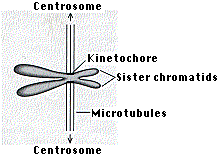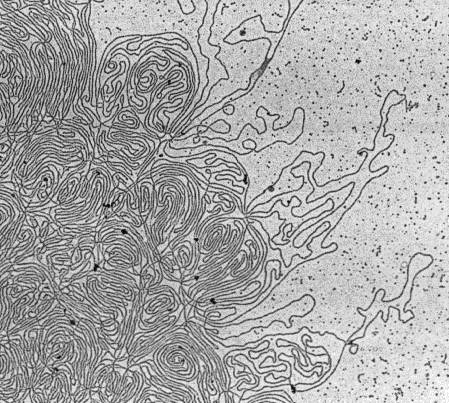
| Index to this page |
There are so many mitochondria and ribosomes in the cell that each daughter cell is usually assured of getting some. But ensuring that each daughter cell gets two (if diploid) of every gene in the cell requires the greatest precision.
This image (provided by J. R. Paulson and U. C. Laemmli) provides a graphic illustration of the problem. It shows a bit (no more than 3%) of the single molecule of DNA released from a single human chromosome. (The chromosome was treated to remove its histones). Remembering that this is 3% of the DNA of only one of the 46 chromosomes in the human diploid cell, you can appreciate the problem faced by the cell of how to separate without error these great lengths of DNA without creating horrible tangles.

The answer:
| Link to discussion of the cell cycle. |
Steps 3 - 5 are accomplished by mitosis. It distributes one of each duplicated chromosome (as well as one centriole) to each daughter cell. It is convenient to consider mitosis in 5 phases.
When a cell is not engaged in mitosis (which is most of the time), it is said to be in interphase.
| Link to a discussion of the spindle checkpoint in the cell cycle. |
| Link to a discussion of the role of spindle fibers and microtubule motors in the chromosome movements of mitosis. |
The sister kinetochores suddenly separate and each moves to its respective pole dragging its attached chromatid (chromosome) behind it.
Separation of the sister chromatids depends on the breakdown of the cohesins that have been holding them together.
It works like this.
|
Mitosis is the process of separating the duplicates of each of the cell's chromosomes. It is usually followed by division of the cell. However, there are cases (cleavage in the insect embryo is an example) where the chromosomes undergo the mitotic process without division of the cell. Thus a special term, cytokinesis, for the separation of a cell into two.
In animal cells, a belt of actin filaments forms around the perimeter of the cell, midway between the poles. The interaction of actin and a myosin (not the one found in skeletal muscle) tightens the belt, and the cell is pinched into two daughter cells.
In plant cells, a membrane-bounded cell plate forms where the metaphase plate had been. The cell plate, which is synthesized by the Golgi apparatus, supplies the plasma membrane that will separate the two daughter cells. Synthesis of a new cell wall between the daughter cells also occurs at the cell plate.
| External Links |
| Mitosis is a dynamic process. Link to John Kyrk's animation of it. |
| Link to movie (7.6 MB) of mitosis in a plant cell. (Click on "Real Movie of plant mitosis") |
| Please let me know by e-mail if you find a broken link in my pages.) |
| Welcome&Next Search |